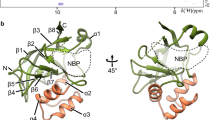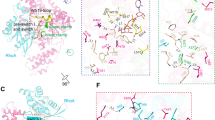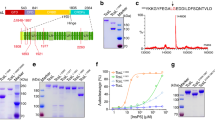Abstract
The actin cytoskeleton is regulated by GTP-hydrolysing proteins, the Rho GTPases1,2, which act as molecular switches in diverse signal-transduction processes3. Various bacterial toxins can inactivate Rho GTPases by ADP-ribosylation1 or glucosylation4. Previous research has identified Rho proteins as putative targets for Escherichia coli cytotoxic necrotizing factors 1 and 2 (CNF1 and 2)5,6. These toxins induce actin assembly and multinucleation in culture cells. Here we show that treatment of RhoA with CNF1 inhibits the intrinsic GTPase activity of RhoA and completely blocks GTPase activity stimulated by the Rho-GTPase-activating protein (rhoGAP). Analysis by mass spectrometry and amino-acid sequencing of proteolytic peptides derived from CNF1-treated RhoA indicate that CNF1 induces deamidation of a glutamine residue at position 63 (Gln 63) to give constitutively active Rho protein.
This is a preview of subscription content, access via your institution
Access options
Subscribe to this journal
Receive 51 print issues and online access
$199.00 per year
only $3.90 per issue
Buy this article
- Purchase on Springer Link
- Instant access to full article PDF
Prices may be subject to local taxes which are calculated during checkout






Similar content being viewed by others
References
Paterson, H. F. Microinjection of recombinant p21rhoinduces rapid changes in cell morphology. J. Cell Biol. 111, 1001–1007 (1990).
Machesky, L. M. & Hall, A. Rho: A connection between membrane receptor signalling and the cytoskeleton. Trends Cell Biol. 6, 304–310 (1996).
Lim, L., Manser, E., Leung, T. & Hall, C. Regulation of phosphorylation pathways by p21 GTPases—the p21 Ras-related Rho subfamily and its role in phosphorylation signalling pathways. Eur. J. Biochem. 242, 171–185 (1996).
Just, I.et al. Glucosylation of Rho proteins by Clostridium difficile toxin B. Nature 375, 500–503 (1995).
Oswald, E.et al. Cytotoxic necrotizing factor type 2 produced by virulent Escherichia coli modifies the small GTP-binding proteins Rho involved in assembly of actin stress fibers. Proc. Natl Acad. Sci. USA 91, 3814–3818 (1994).
Fiorentini, C.et al. Escherichia coli cytotoxic necrotizing factor 1: Evidence for induction of actin assembly by constitutive activation of the p21 Rho GTPase. Infect. Immun. 63, 3936–3944 (1995).
Caprioli, A., Falbo, V., Roda, L. G., Ruggeri, F. M. & Zona, C. Partial purification and characterization of an Escherichia coli toxic factor that induces morphological cell alterations. Infect. Immun. 39, 1300–1306 (1983).
de Rycke, J.et al. Evidence for two types of cytotoxic necrotizing factor in human and animal clinical isolates of Escherichia coli. J. Clin. Microbiol. 28, 694–699 (1990).
Falzano, L.et al. Induction of phagocytic behaviour in human epithelial cells by Escherichia coli cytotoxic necrotizing factor type 1. Mol. Microbiol. 9, 1247–1254 (1993).
Leonard, D. A., Evans, T., Hart, M., Cerione, R. A. & Manor, D. Investigation of the GTP-binding/GTPase cycle of Cdc42Hs using fluorescence spectroscopy. Biochemistry 33, 12323–12328 (1994).
Ridley, A. J. Microinjection of Rho and Rac into quiescent Swiss 3T3 cells. Methods Enzymol. 256, 313–320 (1995).
Diekmann, D. & Hall, A. In vitro binding assay for interactions of Rho and Rac with GTPase-activating proteins and effectors. Methods Enzymol. 256, 207–215 (1995).
Renshaw, M. W., Toksoz, D. & Schwartz, M. A. Involvement of the small GTPase Rho in integrin-mediated activation of mitogen-activated protein kinase. J. Biol. Chem. 271, 21691–21694 (1996).
Der, C. J., Finkel, T. & Cooper, G. M. Biological and biochemical properties of human rasHgenes mutated at codon 61. Cell 44, 167–176 (1986).
Schweins, T.et al. Substrate-assisted catalysis as a mechanism for GTP hydrolysis of p21rasand other GTP-binding proteins. Nature Struct. Biol. 2, 36–44 (1995).
Just, I.et al. Clostridium difficile toxin B acts on the GTP-binding protein Rho. J. Biol. Chem. 269, 10706–10712 (1994).
Hiratsuka, T. New ribose-modified fluorescent analogs of adenine and guanine nucleotides available as substrates for various enzymes. Biochim. Biophys. Acta 742, 496–508 (1983).
Falbo, V., Pace, T., Picci, L., Pizzi, E. & Caprioli, A. Isolation and nucleotide sequence of the gene encoding cytotoxic necrotizing factor 1 of Escherichia coli. Infect. Immun. 61, 4909–4914 (1993).
Aktories, K. & Just, I. In vitro ADP-ribosylation of Rho by bacterial ADP-ribosyltransferases. Methods Enzymol. 256, 184–195 (1995).
Just, I., Selzer, J., Von Eichel-Streiber, C. & Aktories, K. The low molecular mass GTP-binding protein Rho is affected by toxin A from Clostridium difficile. J. Clin. Invest. 95, 1026–1031 (1995).
Horiguchi, Y., Senda, T., Sugimoto, N., Katahira, J. & Matsuda, M. Bordetella bronchiseptica dermonecrotizing toxin stimulates assembly of actin stress fibers and focal adhesions by modifying the small GTP-binding protein rho. J. Cell Sci. 108, 3243–3251 (1995).
Wilm, M. & Mann, M. Analytical properties of the nanoelectrospray ion source. Anal. Chem. 68, 1–8 (1996).
Acknowledgements
We thank I. Just for critical reading of the manuscript.
Author information
Authors and Affiliations
Corresponding author
Rights and permissions
About this article
Cite this article
Schmidt, G., Sehr, P., Wilm, M. et al. Gln 63 of Rho is deamidated by Escherichia coli cytotoxic necrotizing factor-1. Nature 387, 725–729 (1997). https://doi.org/10.1038/42735
Received:
Accepted:
Issue Date:
DOI: https://doi.org/10.1038/42735
This article is cited by
-
Pelargonium sidoides extract mediates nephrotoxicity through mitochondrial malfunction and cytoskeleton destabilization
Toxicological Research (2023)
-
From signal transduction to protein toxins—a narrative review about milestones on the research route of C. difficile toxins
Naunyn-Schmiedeberg's Archives of Pharmacology (2023)
-
Lack of adducin impairs the stability of endothelial adherens and tight junctions and may be required for cAMP-Rac1-mediated endothelial barrier stabilization
Scientific Reports (2022)
-
Characterization of Photorhabdus Virulence Cassette as a causative agent in the emerging pathogen Photorhabdus asymbiotica
Science China Life Sciences (2022)
-
Escherichia coli Rho GTPase-activating toxin CNF1 mediates NLRP3 inflammasome activation via p21-activated kinases-1/2 during bacteraemia in mice
Nature Microbiology (2021)
Comments
By submitting a comment you agree to abide by our Terms and Community Guidelines. If you find something abusive or that does not comply with our terms or guidelines please flag it as inappropriate.



